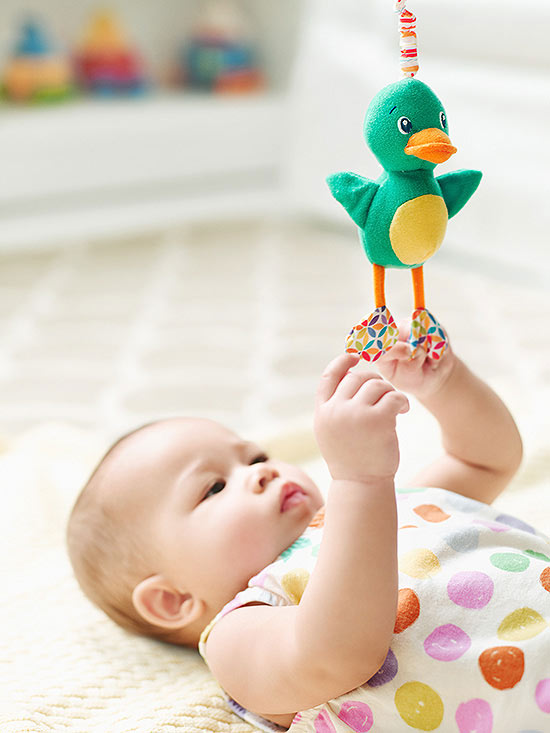
How It Happens
Your infant's fists have been mostly clenched since he was in the womb, and he'll only grasp reflexively for the first 2 months. Once he intentionally opens and closes his fingers at about 3 months, these skills will be next:
- Batting: Some swipe randomly at just a few weeks, but most babies don't bat with a purpose, such as at hanging toys, until about 4 months.
- Grasping: A newborn's reflexive grip is strongest at about 2 months, then gradually decreases. He'll start using his palm and forefingers to hold and shake toys at about 4 months.
- Bringing objects to his mouth: Baby will first get a mouthful of fingers at about 4 months, and he'll soon want to gum everything.
- Passing from hand to hand: Most babies can move toys from one hand to the other at 6 to 8 months, about the same time they start grabbing for toys that are out of their reach.
Encourage It!
"Hand movements are one of the early ways a child explores her world and communicates," notes Pamela High, M.D., head of developmental-behavioral pediatrics at Hasbro Children's Hospital, in Providence, Rhode Island. "Babies can use gestures before they're able to use words." Help your sweetie along:
Give choices: Offer playthings in different shapes and textures so she gets to use her hands in a variety of ways, says Laura Jana, M.D., a pediatrician in Omaha, Nebraska, and coauthor of Heading Home With Your Newborn. Holding a wooden rattle is a different sensation than a crinkly plush caterpillar.
Hand it over: At first you'll need to put a toy right into Baby's hand since she doesn't have the ability to grab much herself. You can also tickle and touch her fingers with a toy to get her attention. Once she starts rolling and scooting, place toys on the ground slightly out of her reach during tummy time to encourage grasping.
Should You Worry?
There isn't a big range for hand milestones in healthy babies born full-term, so talk to your pediatrician if your little one doesn't intentionally grasp objects by 6 months, Dr. Jana says. Also book a checkup if he shows early signs of preferring his right or left hand. Babies shouldn't develop handedness until at least their first birthday. "If young babies are clearly doing so, we worry about the hand they aren't using," Dr. High explains.
Watch for Choking Hazards
Once your baby can get her hands in her mouth, other objects (including choking hazards!) are next. To determine what toys are safe, use the toilet paper roll test: Items small enough to fit inside the roll could block her airway, and should be put away.
Originally published in the September 2015 issue of American Baby magazine.
All content on this Web site, including medical opinion and any other health-related information, is for informational purposes only and should not be considered to be a specific diagnosis or treatment plan for any individual situation. Use of this site and the information contained herein does not create a doctor-patient relationship. Always seek the direct advice of your own doctor in connection with any questions or issues you may have regarding your own health or the health of others.
American Baby
